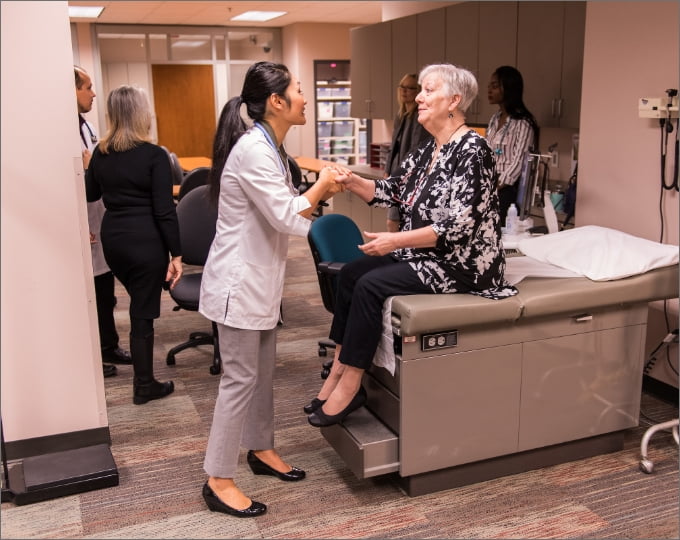
Transitioning from Staff Nurse to Nurse Practitioner: How to Prepare for Your First Year
June 2, 2020Transitioning from staff nurse to nurse practitioner can be challenging. In your first year, you'll be making a move from an experienced registered nurse (RN) to a novice family nurse practitioner (FNP).
The good news is you're not alone. Every year, thousands of new FNPs enter the U.S. workforce.
Many encounter the same trials in transitioning from staff nurse to nurse practitioner.
Read on to learn what you may face and the steps you can take to ease the transition into the role you will have worked so hard to achieve.
You'll also find out how Texas Woman's University's online Master of Science - Family Nurse Practitioner degree prepares graduates for their transitions to FNP.

What Are the Challenges in Transitioning from Staff Nurse to Nurse Practitioner?
Transitioning from staff nurse to nurse practitioner is a huge change.
If you're like most first-year FNPs, you'll confront new circumstances that will test your clinical and leadership competence. In this section, we'll examine the most common.
Each challenge presents an opportunity for personal and professional growth, and knowing what to expect can make your transition more comfortable.
Challenge #1: Training can be limited for those transitioning from staff nurse to nurse practitioner.
Many employers require new employees to complete an orientation process. In nursing, almost every new RN receives formal training.
But many nurses transitioning from staff nurse to nurse practitioner don't get this type of structured support. In one survey, 67% of NPs said they did not have an orientation for their first NP job.
The NPs who completed an orientation had more positive experiences transitioning from staff nurse to nurse practitioner.
Why is training so crucial for new NPs? Research shows that orientations reduce stress. They help NPs feel confident, competent and satisfied in their new role.
Orientation for first-year NPs can take many shapes. At the University of Maryland Medical Center, it has several components, including:
- Twelve to 26 weeks of additional training in the core NP competencies, which prepares new NPs to practice autonomously
- An overview of the NP role, the model of care and implementation strategies
- Clarification of the NP job description
- Information sessions about the hospital and advanced practice nursing, which cover regulatory requirements, computer training, access to systems and business and office supplies
- An explanation of professional practice evaluation
Without formal training, new FNPs are left with an enormous task – finding ways to learn all of this information on their own.
It's no surprise, then, that a lack of structured support can negatively affect those transitioning from staff nurse to nurse practitioner.
If your employer doesn't offer a new FNP orientation, don't worry. Later in this blog post, we'll explore how to learn the ins and outs of your new role.

Challenge #2: Transitioning from staff nurse to nurse practitioner can cause identity confusion.
Transitioning from staff nurse to nurse practitioner can lead to what researchers call identity confusion. One day, you're an experienced RN, and the next, you're a novice FNP.
This sudden change can affect you in several ways. According to research, the most comment effects on new NPs are:
- Decreased self-confidence
- Hindered development of their new role
- Influence on their decisions to leave the NP job and the profession
What exactly causes identity confusion? Individuals transitioning from staff nurse to nurse practitioner will face situations that can spark uncertainty in their new FNP role.
Here are three examples:
Negative Interactions with Co-workers
Without interdisciplinary health education, other health care providers might not understand the NP role. This can confuse the health care team and affect collaboration.
For example, research shows that when physicians lack knowledge of the NP role, it hinders collaboration with NPs.
Patients Who Are Not Open to NPs
Patient visits to NPs continue to rise, and evidence shows that NPs have higher patient satisfaction reviews than physicians.
Still, people transitioning from staff nurse to nurse practitioner may encounter patients who prefer to see doctors. As a result, new NPs may not be able to practice to the full extent of their training.
Complex, Varying Practice Laws
The scope of NP practice varies by state. Thanks to recent changes in nursing practice laws, NPs have a growing scope of practice.
But the changes also mean individuals transitioning from staff nurse to nurse practitioner must stay current on practice regulations. This can be an overwhelming task for new NPs, leading to uncertainty about their role.
Fortunately, focusing on communication and collaboration can help you overcome these challenges. Continue reading to learn how.

Challenge #3: New FNPs must practice independently for the first time.
Another potential difficulty in transitioning from staff nurse to nurse practitioner is embracing new independence.
Gaining more autonomy is one reason why people choose to become FNPs. But independence comes with its own set of challenges.
Transitioning from staff nurse to nurse practitioner responsibilities is a big jump.
For example, as an RN, you might perform a diagnostic test. But as an FNP, you might also order and interpret it. While RNs primarily follow directives, FNPs are responsible for giving them.
As a new FNP, you'll need to immediately apply the clinical knowledge and skills you gained in graduate school. At the same time, you must serve as a leader to other members of the health care team.
This newfound autonomy can be equal parts thrilling and discouraging, creating a dubious first year for NPs. Many report feelings of "faking it," insecurity and "doing it alone."

How Can I Succeed in Transitioning from Staff Nurse to Nurse Practitioner?
Your first year as an FNP will come with a variety of new experiences and emotions.
But there are many ways to start your role on the right foot. Use the following approaches to build confidence in your practice and independence as a new FNP.
Begin the process of transitioning from staff nurse to nurse practitioner by finding a mentor.
According to the Institute of Medicine's landmark Future of Nursing report, exceptional and effective nurses are the best means for developing other exceptional and effective nurses.
Your mentor can help grow your confidence, improve your assessment and diagnostic skills, increase your exposure to clinical situations and serve as a model for behavior.
That's why it's so critical to find a mentor in your first year as an FNP. An experienced FNP will help you navigate the ups and downs and build the foundation for an enduring career.

How Do I Find a Mentor?
As you are transitioning from staff nurse to nurse practitioner, here's where to look for a mentor:
Your Workplace
If your employer offers a formal mentoring program or FNP fellowships, sign up to participate. The benefit of employer programs is that your mentor will be familiar with the expectations of your role and workplace.
Nursing School
You can also connect with your past educators and preceptors. These people already know you, so you can skip the introductory phase and start leveraging the relationship right away.
Nursing Organizations
Many nursing organizations offer mentoring programs and career guidance. For example, the Fellows of the American Association of Nurse Practitioners connects experienced and novice NPs across the country. For a virtual option, check out the American Nurses Association Mentorship Program. It's an online tool for networking and career development.

How Do I Make the Most of Mentorship?
Once you find a mentor, focus on maximizing the relationship.
According to the American Association of Nurse Practitioners (AANP), a mentorship should benefit the mentee and mentor and guide the mentee toward their professional goals. It should involve time, energy, initiative and follow-through.
A successful mentorship depends on mutual commitment. For your part as the mentee, keep the following tips in mind.
Establish Goals
Together with your mentor, set clear goals related to transitioning from staff nurse to nurse practitioner. These objectives will provide you both with a sense of purpose and direction. Also, make sure to discuss how you'll measure progress.
Communicate Regularly
Establish a schedule for connecting with your mentor. Rely on your mentor as an accountability partner, checking in about your progress and questions often.
Be Open
Perhaps the greatest benefit of mentorship is receiving feedback. Be open to feedback and recognize that it will help you improve as a new NP. Be honest about what you know and ask questions when you don't understand.
Maintain a Long-Term Focus
A meaningful mentorship will extend beyond your first year as an FNP. Nurture it as you would a close friendship.

Understand the expectations of transitioning from staff nurse to nurse practitioner.
Your employer may or may not offer formal FNP training. Regardless, you can avoid the potential confusion of transitioning from staff nurse to nurse practitioner by clarifying your role.
Find out exactly what your employer and supervisor expect of you as a new FNP. This information will help you feel more confident about jumping in.
Make sure you understand the following components:
Your Job Description
Request a copy of your job description. Make sure it includes critical information like your responsibilities, work hours and estimated patient load.
Practice Expectations
AANP recommends that NPs should ask their new employer specific questions about their scope of practice:
- Will you be able to practice to the full extent of your training?
- Are the employer's barriers to practice more stringent than those in state laws?
- Will your employer expect you to work outside of your scope of practice?
Standards of Care
Review your employer's standards of care for specific patients, illnesses and clinical scenarios. Also, find out where you can reference them later.
Team Structure
Understand how your role in the health care team relates to your colleagues. Find out about the management structure, the duties you're expected to carry out and what tasks are assigned to other providers.
To promote mutual understanding, ask whether your colleagues have received the same information.
Performance Evaluation
Determine how your supervisor will measure your performance during the first year.
You may also consider making a plan for performance evaluation in the first 100 days. Regular feedback sessions with your supervisor will help you identify your strengths and the areas where you need to improve as a new FNP.
Support Resources
You will undoubtedly have questions while transitioning from staff nurse to nurse practitioner.
Learn what resources are available to help you. Who can you talk to? What continuing education does your employer offer or require?

Transitioning from staff nurse to nurse practitioner relies on building strong professional relationships.
Collaboration drives the best care. When team members have received interprofessional education, patients benefit.
Evidence shows that interprofessional education results in higher patient satisfaction, improved health outcomes of people with certain chronic diseases and fewer medical errors.
As a new FNP, spend time cultivating collaborative relationships with your colleagues. Doing so will help you promote knowledge of the FNP role, foster high-quality and safe patient care and practice effectively in your new job.

How Can I Form Strong Professional Relationships?
Research suggests the following strategies for enhancing communication, especially between nurses and physicians. Use them while transitioning from staff nurse to nurse practitioner:
- Develop emotional maturity. Emotionally mature team members are positive, accountable and focused on continuous improvement. Understand how you contribute to the health care team and recognize the strengths and limitations of other providers.
- Understand different perspectives. As a nurse, you have a unique perspective on patient care. Your colleagues from other health professions do, too. To foster collaboration, value all of their viewpoints and view each team member as an asset.
- Avoid compassion fatigue. Many health care providers develop compassion fatigue at some point in their careers. This indifference causes tiredness and a lack of energy, which can impede communication with colleagues. To maintain your empathy and motivation in the workplace, regularly practice self-care.

How Do Health Care Organizations Promote Collaboration?
Nurses transitioning from staff nurse to nurse practitioner play an essential role in encouraging collaboration.
Organizations also are doing their part to boost interprofessional teamwork. Over time, their initiatives will ease new FNP transitions by enhancing partnerships among nurses and other members of the health care team.
Here are the highlights of these collaborative improvement efforts:
- Colorado is establishing interprofessional teams at community health centers.
- Hawaii is creating an interprofessional workforce database.
- Virginia is developing a pilot clinical leadership program that will encourage pairings between nurses and other providers.
- Twelve states have or are in the process of creating an interprofessional collaborative practice/education model.
- The total number of required interdisciplinary clinical courses at 10 large nursing schools increased from six to 17 between 2011 and 2017.

Leverage your prior nursing experience.
Research is mixed on the role of prior nursing experience in transitioning from staff nurse to nurse practitioner.
Some evidence suggests that NPs with less RN experience will need more time to transition. Other evidence finds no link between RN experience and NP clinical skills.
Regardless of the time you spent working as an RN, you can use your experience in your first year as an FNP.
Embrace your previous strengths and weaknesses. Being aware of these as you begin the FNP role can boost your confidence, lessen your anxiety and keep you focused on improvement.
Also, consider the similarities between your RN and FNP roles. For example, you may be working in the same setting or with a similar clientele. Recognizing how the roles overlap can give you a sense of familiarity and comfort with your new FNP role.

Recall your motivation for transitioning from staff nurse to nurse practitioner.
Your decision to advance your practice and become an FNP was rooted in careful thought.
When you meet trying times in transitioning from staff nurse to nurse practitioner, think of your “why.” Reflecting on your motivation for entering the profession can calm and refocus you.
Enrique Roman decided to earn his online MS-FNP at Texas Woman's University after working in a hospital setting for nine years.
“In my nursing career, I have learned that many gaps exist in our health care system,” Roman said. “One is access to a primary care provider. I chose to go back to school so that I could become a provider who can fill that gap while having increased autonomy.”
As an FNP, you'll have a unique opportunity to:
- Help people and be part of a supportive team. With a broader scope of practice, you'll be serving patients of all ages and backgrounds. You'll also be able to lend your unique blend of medical and nursing preparation to an interdisciplinary health care team.
- Reach a higher level in nursing and make a difference. As an advanced practice registered nurse, you'll have a more direct role in patient care.
- Have more influence over outcomes and more professional autonomy. FNPs are licensed, independent health practitioners who are leaders in health care. You will not only serve clients directly but advance patient care at an organization and systems level.
It's also worth noting that FNP is one of the most sought-after occupations.
U.S. News & World Report ranked NP among the top five jobs in health care, STEM and in the country overall. As an FNP, you'll enjoy a substantial salary, a strong job market and a positive forecast for future employment growth.

Get More Information
Texas Woman's University offers an accredited online MS-FNP designed for BSN-prepared nurses.
It will help you evolve as a holistic primary care provider. You'll build advanced clinical expertise, critical thinking ability and leadership skills to support the entire patient experience.
For Enrique Roman, a 2019 graduate of Texas Woman's MS-FNP program, clinical experiences were a highlight during his time at TWU.
"Texas Woman's University set me up with excellent clinical sites. I had strong preceptors who helped me gain confidence and added to my knowledge, which I use in my day-to-day as a patient care provider."
Are you ready to begin transitioning from staff nurse to nurse practitioner?
Learn how Texas Woman's online FNP program can help.

